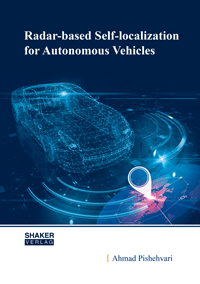
Shop : Details
Shop
Details
49,80 €ISBN 978-3-8440-7874-9Softcover262 pages82 figures390 g21 x 14,8 cmEnglishThesis
March 2021
Ahmad Pishehvari
Radar-based Self-localization for Autonomous Vehicles
Autonomous driving is developing from an insurmountable aspiration into a more realistic vehicle's feature radically transforming the transportation system. Implementing a self-localization system with an accurate performance is a fundamental and substantial challenge for accomplishing this objective. Global navigation satellite systems are frequently implemented to register the absolute position and orientation of the vehicle. However, in the absence of satellite signals, an alternative is required to ensure the unimpaired functionality of the self-localization system. A widely applied method with a straightforward implementation is dead reckoning as a self-localization technique based on mechanical motion sensors. A major disadvantage of such a system is the self-localization inaccuracy due to the sensing system errors propagating over time. Access to an environment map allows the application of registration techniques using environment perception through appropriate sensing systems. In this book, the realization of the map registration algorithms is performed with radars, as they perceive the environment regardless of weather and light conditions. New radar-based self-localization solutions are conceptualized and implemented for GNSS-restricted areas utilizing registration of environment models and sequential Monte-Carlo method. A map registration algorithm is proposed utilizing radar observations and OpenStreetMap initialized with dead reckoning. Moreover, a particle filtering approach is implemented to realize absolute self-localization with divergence avoidance strategies. As the preeminent contribution of this book, the map registration of radar measurements is transferred from Cartesian coordinates to Range-Doppler coordinates offering significant advantages.
Keywords: Self-localization; Autonomous Driving; Radar; Map registration; Range-Doppler registration; Particle filtering; Dead Reckoning; Map matching; Sequential Monte Carlo
Available online documents for this title
You need Adobe Reader, to view these files. Here you will find a little help and information for downloading the PDF files.
Please note that the online documents cannot be printed or edited.
Please also see further information at: Help and Information.
Please also see further information at: Help and Information.
| Document |  | Document | ||
| Type |  | |||
| Costs |  | 37,35 € | ||
| Action |  | Purchase in obligation and download the file | ||
| Document |  | Table of contents | ||
| Type |  | |||
| Costs |  | free | ||
| Action |  | Download the file | ||
User settings for registered online customers (online documents)
You can change your address details here and access documents you have already ordered.
User
Not logged in
Export of bibliographic data
Shaker Verlag GmbH
Am Langen Graben 15a
52353 Düren
Germany
Am Langen Graben 15a
52353 Düren
Germany
Mon. - Thurs. 8:00 a.m. to 4:00 p.m.
Fri. 8:00 a.m. to 3:00 p.m.
Fri. 8:00 a.m. to 3:00 p.m.
Contact us. We will be happy to help you.



